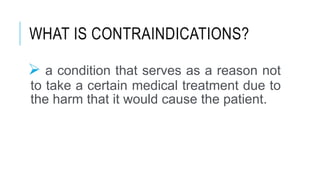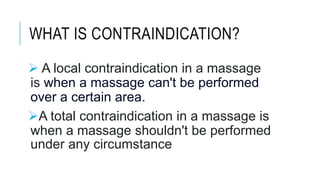CONTRAINDICATIONS in TLE Wellness Massage
- 2. WHAT IS CONTRAINDICATIONS? ’āś a condition that serves as a reason not to take a certain medical treatment due to the harm that it would cause the patient.
- 3. WHAT IS CONTRAINDICATION? ’āś A local contraindication in a massage is when a massage can't be performed over a certain area. ’āśA total contraindication in a massage is when a massage shouldn't be performed under any circumstance
- 4. CARDIO-VASCULAR PROBLEMS ’āś Massage is thought to increase blood flow, which is desirable in many conditions, but can be dangerous in others.
- 5. LYMPHATIC DRAINAGE The lymphatic system removes excess fluid from all over the body, returning it into the bloodstream. Because massage increases lymphatic flow, the rate in which these toxic substances are carried and spread around the body is increased. Be particularly aware if the client has swollen or painful lymph glands; do
- 6. SKIN CONTACT AND FRICTION As the hands move over the clientŌĆśs skin, any bacterial, viral or fungal infections can be spread over the skin to a non-infected area or onto the therapistŌĆśs hands. Infections may be transmitted from client to therapist or from therapist to client in this way.
- 7. HEALING PROCESS ’āś Any injury or damage to the tissues or fractures of bones must be allowed to heal completely before massage is given to the area. If massage is given before healing is complete, there is a danger of further damage to the tissues and delaying the healing process.
- 8. PINS AND PLATES ’āś If massage is performed over an area where pins and plates have been inserted to stabilise bones and joints, there is a danger of their becoming loose, and also, through the pressure of massage over any protruding parts, there is a danger of damaging the surrounding soft tissues.
- 9. ALLERGIC REACTIONS ’āś The oil or cream etc. used as the massage medium may cause an allergic reaction in some clients. This will produce an excessive erythema: the area becoming very red and hot or a rash may appear. ’āśRemove the medium immediately and wash in warm water.
- 10. FRAGILE SKIN ’āś There is always a danger of breaking down fragile, thin skin, causing open wounds. ’āśParticular care must be taken with diabetics and anyone on steroid treatments as the skin may be fragile and healing may be slow. ’āśPlenty of lubrication and light pressure only must be used.
- 11. INFECTIONS ’āś It is common sense to avoid touching anything infectious such as athleteŌĆśs foot, eczema and also to treat someone if they have a contagious disease such as chicken fox.
- 12. INFLAMMATION ’āś Deep massage worsens any type of inflammation, whether an inflamed injury, irritable bowels, or an inflamed arthritic joint,. ’āśIndications of inflammation include heat, pain or discomfort, swelling, and redness. ’āśLight, gentle stroking, however, may offer some relief and comfort.
- 13. CANCER ’āś One school of thought postulates that massage can spread cancer through the lymphatic system. While this remains unproven and there is much evidence to dispute the theory, it is a good idea to obtain permission from a doctor before massaging people with cancer.
- 14. PREGNANCY AND FULL STOMACH ’āś During the first three months of pregnancy, do not massage with any pressure on the abdomen and lower back, this is the most common time period for miscarriage, and massage can stimulate contractions. ’āśDuring the two or three days of menstruation, massage on the abdomen and lower back may make bleeding heavier, check your partners preference before giving a massage. ’āśAvoid massaging if someone has just eaten, as the massage could make them feel nauseated.













